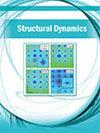A versatile experimental system for tracking ultrafast chemical reactions with X-ray free-electron lasers
IF 2.3
2区 物理与天体物理
Q3 CHEMISTRY, PHYSICAL
引用次数: 12
Abstract
An experimental system, SPINETT (SACLA Pump-probe INstrumEnt for Tracking Transient dynamics), dedicated for ultrafast pump-probe experiments using X-ray free-electron lasers has been developed. SPINETT consists of a chamber operated under 1 atm helium pressure, two Von Hamos spectrometers, and a large two-dimensional detector having a short work distance. This platform covers complementary X-ray techniques; one can perform time-resolved X-ray absorption spectroscopy, time-resolved X-ray emission spectroscopy, and time-resolved X-ray diffuse scattering. Two types of liquid injectors have been prepared for low-viscosity chemical solutions and for protein microcrystals embedded in a matrix. We performed a test experiment at SPring-8 Angstrom Compact free-electron LAser and demonstrated the capability of SPINETT to obtain the local electronic structure and geometrical information simultaneously.用X射线自由电子激光器跟踪超快化学反应的通用实验系统
已经开发了一个实验系统SPINETT(SACLA泵浦探针INstrumEnt用于跟踪瞬态动力学),专门用于使用X射线自由电子激光器的超快泵浦探针实验。SPINETT由一个在1 大气压氦气、两个Von Hamos光谱仪和一个工作距离短的大型二维探测器。该平台涵盖补充X射线技术;可以执行时间分辨的X射线吸收光谱、时间分辨的X-射线发射光谱和时间分辨的X-射线扩散散射。已经为低粘度化学溶液和嵌入基质中的蛋白质微晶制备了两种类型的液体注射器。我们在SPring-8 Angstrom Compact自由电子激光器上进行了测试实验,证明了SPINETT同时获得局部电子结构和几何信息的能力。
本文章由计算机程序翻译,如有差异,请以英文原文为准。
求助全文
约1分钟内获得全文
求助全文
来源期刊

Structural Dynamics-Us
CHEMISTRY, PHYSICALPHYSICS, ATOMIC, MOLECU-PHYSICS, ATOMIC, MOLECULAR & CHEMICAL
CiteScore
5.50
自引率
3.60%
发文量
24
审稿时长
16 weeks
期刊介绍:
Structural Dynamics focuses on the recent developments in experimental and theoretical methods and techniques that allow a visualization of the electronic and geometric structural changes in real time of chemical, biological, and condensed-matter systems. The community of scientists and engineers working on structural dynamics in such diverse systems often use similar instrumentation and methods.
The journal welcomes articles dealing with fundamental problems of electronic and structural dynamics that are tackled by new methods, such as:
Time-resolved X-ray and electron diffraction and scattering,
Coherent diffractive imaging,
Time-resolved X-ray spectroscopies (absorption, emission, resonant inelastic scattering, etc.),
Time-resolved electron energy loss spectroscopy (EELS) and electron microscopy,
Time-resolved photoelectron spectroscopies (UPS, XPS, ARPES, etc.),
Multidimensional spectroscopies in the infrared, the visible and the ultraviolet,
Nonlinear spectroscopies in the VUV, the soft and the hard X-ray domains,
Theory and computational methods and algorithms for the analysis and description of structuraldynamics and their associated experimental signals.
These new methods are enabled by new instrumentation, such as:
X-ray free electron lasers, which provide flux, coherence, and time resolution,
New sources of ultrashort electron pulses,
New sources of ultrashort vacuum ultraviolet (VUV) to hard X-ray pulses, such as high-harmonic generation (HHG) sources or plasma-based sources,
New sources of ultrashort infrared and terahertz (THz) radiation,
New detectors for X-rays and electrons,
New sample handling and delivery schemes,
New computational capabilities.
 求助内容:
求助内容: 应助结果提醒方式:
应助结果提醒方式:


